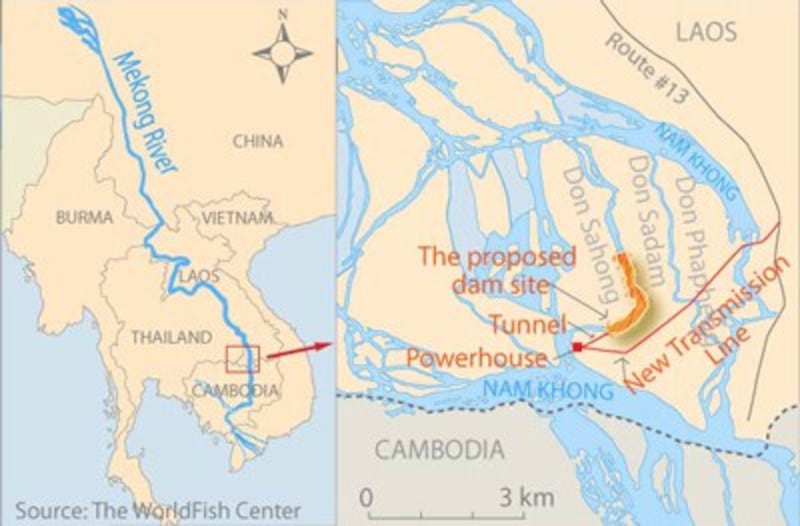Laos dismissed claims Tuesday that it has launched construction of a second dam on the Mekong River, but a conservation group insists that the government has already started preparatory work on the site.
The proposed Don Sahong hydropower project is located on the Mekong River in the Khone Falls area of southern Laos and, like the first and controversial Xayaburi dam project, is subject to approval by a regional body which oversees development on the waterway.
An official from the Lao Ministry of Energy and Mines, who spoke to RFA’s Lao service on condition of anonymity, denied a report by California-based International Rivers released over the weekend, which said workers had begun blasting a fish channel at a site near the planned Don Sahong dam location.
“The Ministry of Energy has not built anything yet,” the official said.
“We still have to go through many processes [before it can be approved].”
Observers say that work on most major projects in Laos begins before receiving official approval.
Pianporn Deetes, International Rivers’ Thailand coordinator, said that while there had been no construction “of the dam itself,” other preparatory work is under way that should not have proceeded without approval from the four-nation Mekong River Commission (MRC).
“We found that there has been rapid blasting near the dam site in an area called Hou Xang Noi. Villagers say it is a new channel to act as a fish passage to bypass the Don Sahong,” she told RFA.
“Most importantly, those preparatory works should not have been undertaken because, like in the case of the Xayaburi dam, the Don Sahong has not been given consent by the other lower Mekong countries yet.”

Preparatory work
According to International Rivers, late last year, the dam’s developer, Malaysian company Mega First Corporation Berhad, destroyed a waterfall and blasted a 5-meter (16.5-foot) wide channel for fish to pass through year-round.
The group said that the blasting was an attempt to create an alternative fish passage to the channel which will be used for the dam project, but villagers have said that they will be prohibited from their traditional style of fishing on the new channel beginning in 2014, eliminating a major source of income and food security.
Deetes went on to say that without consent from all of the nations in the MRC—which includes Laos, Vietnam, Thailand, and Cambodia—all work on the project should be stopped, including any preparatory construction.
Laos maintains that mutual consent is not required for “preparatory work” on a Mekong project, but the MRC has not reached an agreement regarding the definition of the term.
As the first dam on the Lower Mekong's main stream, the Xayaburi is also the first to undergo a regional review process through the MRC, which has expressed reservations over the project.
Through the MRC, established in 1995, member countries have agreed to a protocol for consulting with and notifying each other about use of the river’s resources, but the organization has no binding jurisdiction on what Laos does about the two dams.
One study commissioned by the group recommended a 10-year moratorium on all Mekong dams due to a need for further research on their potentially catastrophic environmental and socioeconomic impact.
Project criticism
The 260-380 megawatt Don Sahong dam is being built with the expectation that the electricity it generates will be exported to Thailand or Cambodia, according to International Rivers.
Mega First had announced that the dam’s environmental assessment was approved by the Lao government in April and that it was close to signing a power purchasing agreement with the government for a 30-year concession.
The environmental impact assessment has not been publicly disclosed.
The MRC has already voiced opposition to the Don Sahong, saying in a 2010 Strategic Environmental Assessment that the dam would block the only section of the Mekong where fish can pass during the dry season migration.
That assessment also noted that according to fishery experts, no technology exists to effectively mitigate the threat that main-stream dams pose to the Mekong’s fish population.
Ame Trandem, Southeast Asia program director for International Rivers, said the Don Sahong dam would “spell disaster for the Mekong’s fisheries.”
“The dam would block vital fish migrations and decimate the livelihoods of local people who depend on fish for their food security. Like the Xayaburi dam, the impacts would be transboundary.”
International Rivers’ Deetes said that the Lao government is “repeating the same tricks that it has used with the Xayaburi dam” and called on the MRC to “take action” against the project.
“Before time runs out, it’s crucial that the MRC governments, secretariat, and donors call for an immediate stop to activities at both dam sites,” she said.
In addition to the potential effect on the river's fisheries, International Rivers said, the Don Sahong risks jeopardizing the last remaining population of Irrawaddy freshwater dolphins in Laos, as well as diverting water from the Khone Falls, undermining the area's increasing popularity as a tourist destination.
Reported by Bounchanh Mouangkham and Nontarat for RFA's Lao service. Translated by Somnet Inthapannha. Written in English by Joshua Lipes.
